AM Projects
TOPOLOGY OPTIMIZATION OF AM CELLULAR & LATTICE STRUCTURES
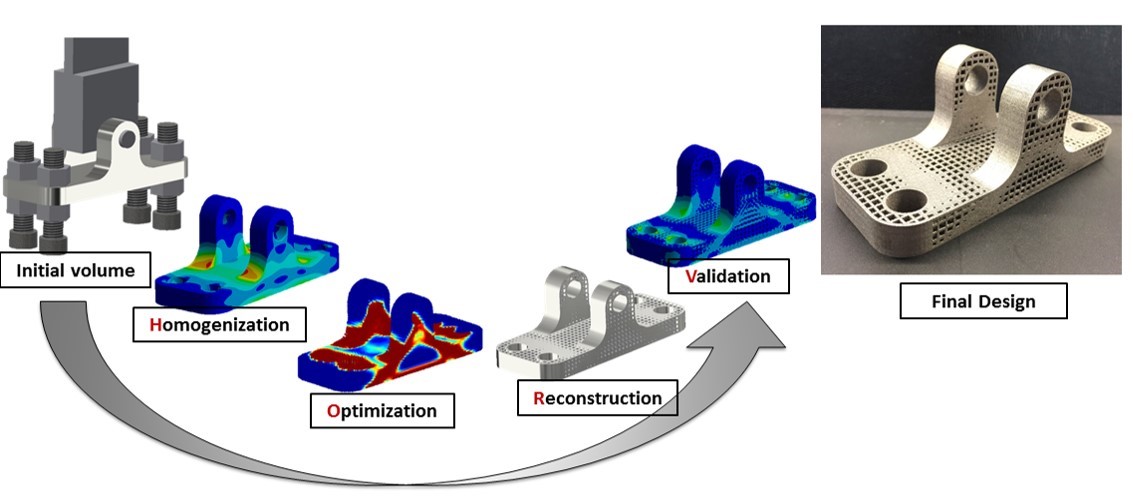
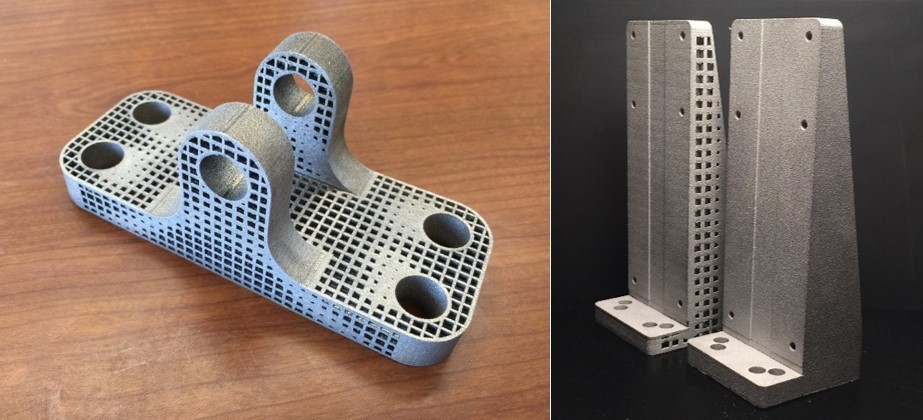
Cellular structures can be employed effectively in lightweight structural design to overcome some of the manufacturing limitations existing in additive manufacturing (AM). For this purpose, a homogenization-based topology optimization method is proposed to optimize variable-density cellular structures efficiently. First, homogenization is performed to capture the effective mechanical properties of cellular structures through the scaling law as a function of relative density. Second, the scaling law is employed directly in the topology optimization algorithm to compute the optimal density distribution for the part being optimized. Third, a new technique is presented to reconstruct the CAD model of the optimal variable-density cellular structure. The proposed method is validated by comparing the results obtained through homogenized model, full scale simulation, and experimentally testing the optimized parts after being additive manufactured. The test examples demonstrate that the proposed homogenization-based method is efficient, accurate, and is able to produce manufacturable designs.
[1] L. Cheng, P. Zhang, E. Biyikli, J. Bai, J. Robbins, M. Lynch, E. Butcher, and A. C. To, “Efficient design optimization of variable-density cellular structures for additive manufacturing: Theory and experimental validation,” Rapid Prototyping Journal, 2017. (in press) [link]
[2] P. Zhang, J. Toman, Y. Yu, E. Biyikli, M. Kirca, M. Chmielus, and A. C. To, “Efficient design-optimization of variable-density hexagonal cellular structure by additive manufacturing: Theory and validation," ASME Journal of Manufacturing Science and Engineering, vol. 137, 021004, 2015. [link]
MODELING MICROSTRUCTURE AND PROPERTY OF AM METALS
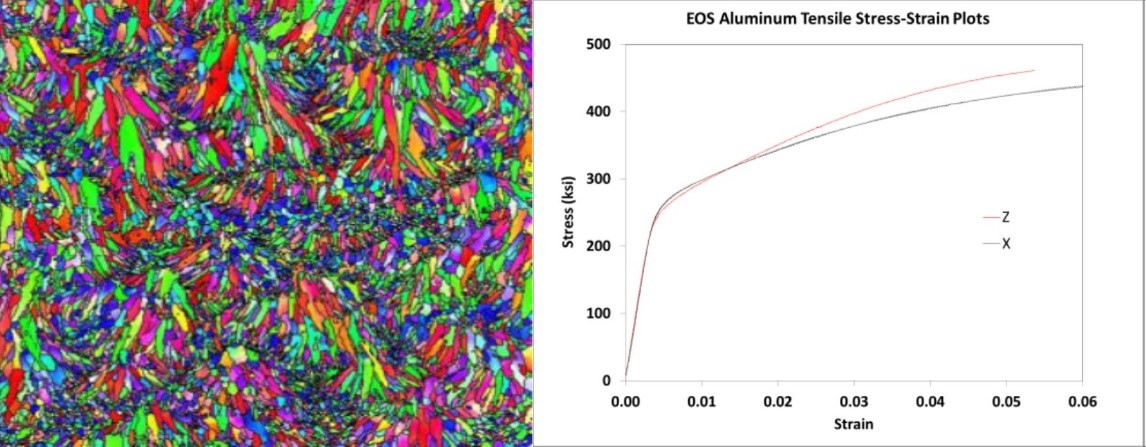
Advances in additive manufacturing (AM) technology have made it possible to manufacture complex-shaped metal components strong enough for real engineering applications. To date, the process-microstructure-property relationship for AM metals has mostly been investigated experimentally, which is expensive and time-consuming since the parameter space is quite large. The lack of a reliable theoretical model for predicting such relationship makes it difficult to design AM components. The goal of this research is to establish a theoretical model that is capable of predicting the microstructure (texture, grain size, shape and subgrain features length scale) and mechanical properties (strength and anisotropy) of an AM metal based on the input process parameters (beam power, scan speed, preheat, and scanning strategy).
[1] J. Liu and A. C. To, "Quantitative texture prediction of epitaxial columnar grains in additive manufacturing using selective laser melting,” Additive Manufacturing, 16, 58-64, 2017. [link]
[2] J. Liu, W. Xiong, A. Behera, S. Thompson, and A. C. To, "Mean-field polycrystal plasticity modeling with grain size and shape effects for laser additive manufactured FCC metals," International Journal of Solids and Structures, 112, 35-42, 2017. [ link]
MULTIRESOLUTION MOLECULAR MECHANICS
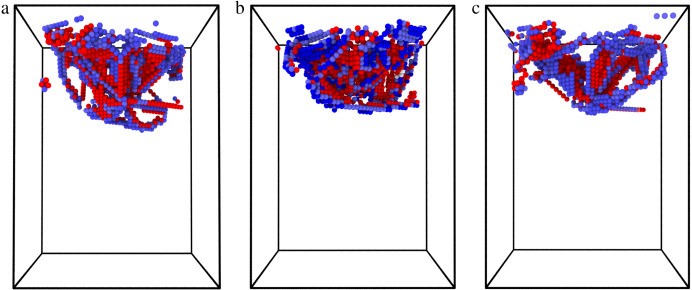
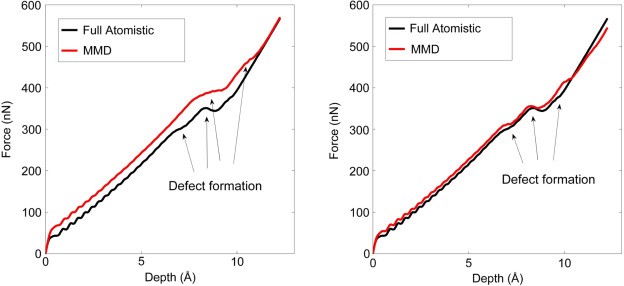
In the last five years, we have been developing a new energy-based concurrent atomistic/continuum framework called the Multiresolution Molecular Mechanics (MMM) that includes formulation for both the statics (MMS) and dynamics (MMD) methods. By introducing a novel energy sampling framework, MMM aims at accurately and efficiently approximating the atomic energy of the system at different resolutions without the cumbersome interfacial treatment in existing methods. The key features of the MMM method are: (1) consistency with the atomistics framework, (2) consistency with the order of shape functions introduced, and (3) flexibility in energy approximation with respect to accuracy and efficiency. Under the energy sampling framework, several sampling schemes have been devised and tested for interface compatibility, and compared to existing methods. The proposed MMM method demonstrates very good accuracy in solving many different problems such as crack propagation and surface relaxation problems when compared to full molecular statics.
[1] E. Biyikli and A. C. To, “Multiresolution molecular mechanics: adaptive analysis,” Computer Methods in Applied Mechanics and Engineering, vol. 305, 682-702, 2016.
[2] Q. Yang and A. C. To, "Multiresolution molecular mechanics: a unified and consistent framework for general finite element shape functions," Computer Methods in Applied Mechanics and Engineering, vol. 283, 384-418, 2015.
MECHANICS OF BIOINSPIRED AND PHONONIC STRUCTURES
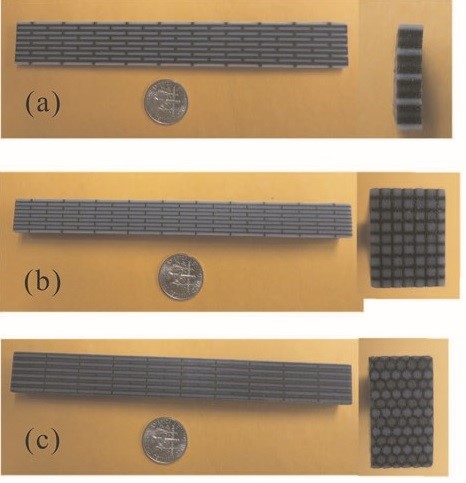
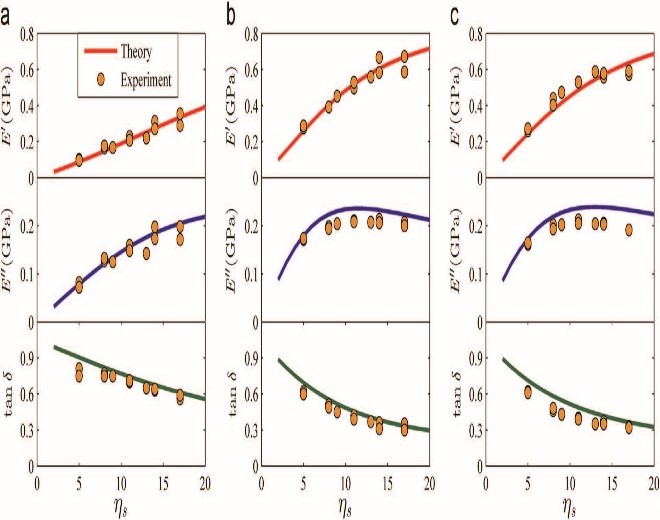
We believe nature optimizes certain mechanical properties of biological materials by designing microstructure. Recently, we have discovered interesting mechanical behaviors in hierarchical structure found in many biocomposites. For example, hierarchical structure can enhance wave filtering and damping figure of merits significantly.
[1] P. Zhang, M. Heyne, and, A. C. To, “Biomimetic staggered composites with highly enhanced energy dissipation: modeling, 3D printing, and testing” Journal of Mechanics and Physics of Solids, vol. 83, 285-300, 2015 [link]
[2] P. Zhang and A. C. To, "Broadband wave filtering of bioinspired hierarchical phononic crystal," Applied Physics Letters, vol. 102, 121910, 2013.
Other Ongoing Projects
A Multiscale Process-Microstructure Simulation Tool for Predicting Defects and Microstructure Evolution by Leveraging GPU Acceleration and Machine Learning
04/2021-03/2024
PI: Albert C. To
Co-PI: Sneha Narra (Carnegie Mellon University)
Agency: National Aeronautics and Space Administration (NASA)
Support: $750,000 (PI, 74%)
Description: The objective of this research is develop a large-scale simulation model to predict microstructure evolution and defect generation in laser powder bed fusion Inconel 718 by leveraging GPU
Wire-Arc Additive Manufacturing of Advanced Steam Cycle Components by Integrated Materials and Mechanical Design with High-Throughput Experimentation and Machine Learning
02/2021-01/2023
PI: Wei Xiong (Pitt)
Co-PI: Albert C To
Agency: NETL
Support: $499,739
Description: to establish a framework capable of efficiently predicting the properties of structural materials for service in harsh environments over a wide range of temperatures and long periods of time
A Gradient-Based Deformation Compensation Method for Minimizing Warpage in Sintered Binder Jetted Parts
07/01/2021-06/2022
PI: Albert C. To
Agency: Manufacturing PA Innovation Program
Support: $70,000
Description: The project will overcome a critical issue that hinders the broad adoption of binder jet printing: the warping of jetted parts after they’re
treated with heat (sintered). The project will develop a new gradient-based method for minimizing warpage that changes the structures such that they will settle into the correct shapes after printing and sintering. To will work with Basil Paudel and Hao Deng, graduate students in mechanical engineering and materials science.
Predictive Thermal Simulation for Laser Powder Bed Fusion
05/2021-06/2022
PI: Chris Barrett (Open Additive LLC)
Co-PIs: Albert C. To
Agency: National Aeronautics and Space Administration (NASA)
Support: $120,000 (co-PI, 45%)
Description: This research aims to develop a thermal process simulation model for laser powder bed fusion by integrating with in-situ monitoring process.
Optimized Subtractive Manufacturing
01/2021-05/2021
PI: Simon Chung (Materials Sciences Corporation)
Co-PI: Albert C. To
Agency: Navy SBIR Phase I
Support: $100,000 (co-PI, 42%)
Description: This research aims to develop a topology optimization method with machining constraint to yield an optimized CAD model that is editable.
Fiber Sensor Fused Additive Manufacturing for Smart Component Fabrication for Nuclear Energy
10/2020-09/2023
PI: Kevin P. Chen (ECE, Pitt)
Co-PI: Albert C. To
Agency: DOE – Nuclear Engineering University Program
Support: $1,000,000 (PI, 30%)
Description: This research aims to develop embedded fiber sensor technology within additive manufactured parts via an integrated experimental and modeling approach.
Data Driven Qualification (DDQ) Framework for Metals Additive Manufacturing (AM)
11/2020-4/2022
PI: Craig Brice (Colorado School of Mines)
Co-PIs: Albert C. To and 10 other co-PIs
Agency: DOE – Nuclear Engineering University Program
Support: $10,000,000 (co-PI, 9%)
Description: My part of the research aims to develop a topology optimization method that can simultaneously design a part for end-use application and reduce residual stress during additive manufacturing processing.
A Computational Tool for Simulating the Sintering Behavior in Binder Jet Additive Manufacturing
08/2020-12/2021
PI: Albert C. To
Industrial Partners: ANSYS & ExOne
Agency: PA Department of Community & Economic Development
Support: $69,450 (PI, 100%)
Description: The objective of this research is to develop a thermomechanical model to simulate the sintering behavior of binder jet material.
Efficient Prediction of Thermal Stresses and Distortion in Complex Optimized Missile Structures
10/2020-09/2022
PI: Carissa Russell (Materials Sciences Corporation)
Co-PI: Albert C. To
Agency: Sequential Army SBIR Phase II
Support: $1,000,000 (co-PI, 40%)
Description: This research aims to develop a fast and accurate simulation model to predict thermal stress and distortion arisen from laser based additive manufacturing processing of complex components.
Development of an Ecosystem for Qualification of Additive Manufacturing Processes and Materials in Aviation
09/2019-08/2022
PI: Anthony Rollett (Carnegie Mellon University)
Co-PIs: Albert C. To and 10 other professors
Agency: National Aeronautics and Space Administration (NASA)
Support: $6,000,000 (co-PI, 6.25%)
Description: The objective of this research is develop manufacturing methods that reduce costs and increase the speed of aircraft manufacture, while maintaining or improving product quality and reliability.
Develop Optimized Bridge Connection Design for Additive Manufacturing (DOCAM)
02/2020-02/2022
PI: Xiaoliang Zhao (Intelligent Automation Inc.)
Co-PI: Albert C. To
Agency: Army SBIR Phase II
Support: $1,000,000 (co-PI, 23.5%)
Description: This research aims to optimize the design for complex metal bridge connections fabricated by additive manufacturing.
An Effective Quality Assurance Method for Additively Manufactured Gas Turbine Metallic Components via Machine Learning from In-Situ Monitoring, Part-scale Modeling, and Ex-Situ Characterization Data
10/2019-09/2022
PI: Xiayun Zhao (MEMS, Pitt)
Co-PIs: Albert C. To, Richard Neu (Georgia Institute of Technology)
Agency: DOE – National Energy Technology Laboratory (NETL)
Support: $800,000 (co-PI, 33%)
Description: This research aims to develop an effective quality assurance method for additively manufactured gas turbine metallic components via machine learning from in-situ monitoring, part-scale modeling, and ex-situ characterization data.
Integrating Dissolvable Supports, Topology Optimization, and Microstructure Design to Drastically Reduce Costs in Developing and Post-Processing Nuclear Plant Components
10/2018-09/2022
PI: Albert C. To
Co-PIs: Wei Xiong (MEMS, Pitt), Owen Hildreth (Colorado School of Mines)
Agency: DOE – Nuclear Engineering University Program
Support: $1,000,000 (PI, 28.5%)
Description: This research aims to develop an integrated approach of dissolvable supports, topology optimization, and microstructure design to achieve low-cost post-processing of additive manufactured nuclear components.